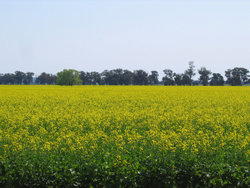Canola
2007 Schools Wikipedia Selection. Related subjects: Food and agriculture
In agriculture, Canola is a trademarked cultivar of the rapeseed plant from which rapeseed oil is obtained. Also known as "LEAR" oil (for Low Erucic Acid Rapeseed), Canola oil was initially bred in Canada by Keith Downey and Baldur Stefansson in the 1970s.
The word "canola" is derived from "Canadian oil, low acid".
History
Once considered a specialty crop in Canada, canola has evolved into a major North American cash crop. Canada and the United States produce between 7 and 10 million metric tons (tonnes) of canola seed per year. Annual Canadian exports total 3 to 4 million metric tons of the seed, 700,000 metric tons of canola oil and 1 million metric tons of canola meal. The United States is a net consumer of canola oil. The major customers of canola seed are Japan, Mexico, China and Pakistan, while the bulk of canola oil and meal goes to the United States, with smaller amounts shipped to Mexico, China and Europe.
Canola was developed through conventional plant breeding from rapeseed, an oilseed plant with roots in ancient civilization. The word "rape" in rapeseed comes from the Latin word "rapum," meaning turnip. Turnip, rutabaga, cabbage, Brussels sprouts, mustard and many other vegetables are related to the two canola species commonly grown: Brassica napus and Brassica rapa. The negative associations with the word "rape" in North America resulted in the more marketing-friendly name "Canola".
Hundreds of years ago, Asians and Europeans used rapeseed oil in lamps. As time progressed, people employed it as a cooking oil and added it to foods. Its use was limited until the development of steam power, when machinists found rapeseed oil clung to water- and steam-washed metal surfaces better than other lubricants. World War II saw high demand for the oil as a lubricant for the rapidly increasing number of steam engines in naval and merchant ships. When the war blocked European and Asian sources of rapeseed oil, a critical shortage developed and Canada began to expand its limited rapeseed production.
After the war, demand declined sharply and farmers began to look for other uses for the plant and its products. Edible rapeseed oil extracts were first put on the market in 1956-1957, but these suffered from several unacceptable characteristics. Rapeseed oil had a distinctive taste and a disagreeable greenish colour due to the presence of chlorophyll. It also contained a high concentration of erucic acid, suspected of causing cancer if ingested in large amounts. Feed meal from the rapeseed plant was not particularly appealing to livestock, due to high levels of sharp-tasting compounds called glucosinolates.
Rapeseed had been grown in Canada (mainly Saskatchewan) since 1936. Canadian plant breeders took up the challenge to improve the quality of the plant. In 1968, Dr. Baldur Stefansson of the University of Manitoba used selective breeding to develop a low erucic acid variety of rapeseed. In 1974 another variety was produced with both a low erucic acid content and a low level of glucosinolates; this was dubbed Canola, from Canadian Oil Low Acid.
A variety developed in 1998 is considered to be the most disease- and drought-resistant variety of Canola to date. Recent varieties such as this have been produced by gene splicing techniques.
Other Canola facts
- Today about 75% of the Canola crops planted in Alberta, Manitoba, and Saskatchewan are GM ( genetically modified food) herbicide-tolerant varieties.
- In 2004, North Dakota produced 91% of the Canola in the United States.
- Compared with sunflower, corn, peanut, and many other oils, Canola has one of the lowest ratios of saturated to unsaturated fat, which has known health benefits.
- The rapeseed blossom is a major source of nectar for honeybees.
- Canola oil is a promising source for manufacturing biodiesel, a renewable alternative to fossil fuels.
- The main price-discovery mechanism for worldwide canola trade is the Winnipeg Commodity Exchange canola futures contract. Rapeseed is traded on the Euronext exchange.



